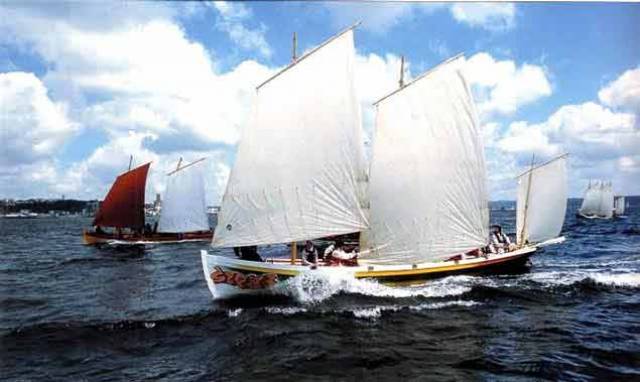Most sailing folk in Ireland will have some level of awareness of the Bantry Boat. Even those who live most determinedly in the present, and look unswervingly to the future, will be vaguely aware that thanks to some fortuitous turns of history, on both sides of the Atlantic we now have flotillas or individual examples of sailing/rowing craft of a classic design which is pushing towards being 250 years old and more in its origins. Old they may be in concept, yet these boats provide a valid combination of rowing and sailing for seamanship and adventure training which has a special resonance today, and in coastal communities, they can be a focal point for active maritime involvement writes W M Nixon.
The ship’s gigs of the 18th Century were a reflection of the vessels they served. One of the best-known of them, the longboat in which Captain Bligh made his astonishing 3,500 mile voyage in 1789 in the Pacific after being set adrift by Fletcher Christian and his fellow-mutineers, was a modest 25-footer which was in keeping with the fact that her mother-ship the Bounty was an ordinary workaday ship just 90ft long.
But the longboat which was left behind on Bere Island after the failed French invasion of Bantry Bay by 43 ships in 1796 was all of 38ft long. For this was the proper 1790-built Admiral’s Gig of a flagship of the Revolutionary Navy, and in size and style she showed the important status of the ship and officers she served.
The slim and elegant service vessel’s abandonment in that rugged part of the world where West Cork is verging into Kerry was ultimately the saving of her, for in time she was taken into the boathouse in Bantry House. And that fortuitous place of shelter was the perfect preservation pod - neither too warm nor too cold, neither too dry nor too damp. Over the years, she was saved for posterity, while her contemporaries and the splendid ship she’d served had themselves long since disappeared completely, most of their plans gone too in the mayhem of war and civic turbulence.
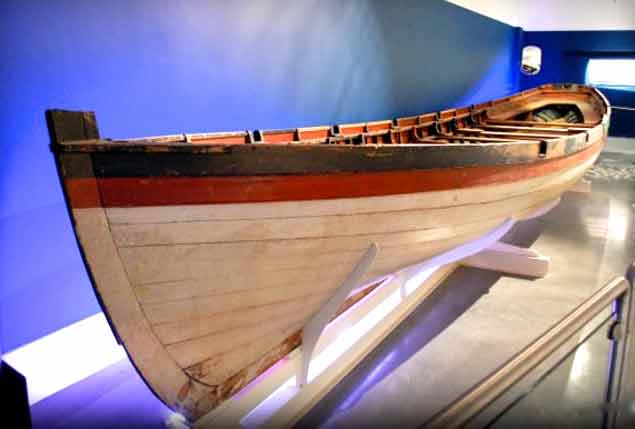 The original “Bantry Boat” – built in Brest in 1790 – is now conserved in the National Museum at Collins Barrack in Dublin
The original “Bantry Boat” – built in Brest in 1790 – is now conserved in the National Museum at Collins Barrack in Dublin
It was around 1943 or even earlier that approaches were made from Bantry House to the Irish Government about accepting responsibility for this significant historical artefact, and in 1944 the authorities took it on. But 38ft is a lot of boat, and for long enough it seemed sufficient simply to find a safe storage space until in 1974 the nascent Maritime Museum of Ireland in Dun Laoghaire took the Bantry Boat on loan as the centre-piece of its growing exhibition.
It’s wellnigh impossible to tabulate just how many projects of maritime history the polymath Hal Sisk has been involved with, both over the years and in the present time. Back in the 1970s and for subsequent decades, the Bantry Boat was just one of them. On such matters, he would be regularly in contact with his friend Bernard Cadoret of the encyclopaedic French magazine Le Chasse Maree. This splendid publication, which he founded in 1981 with his wife Michele, is heroically devoted to the cause of maritime history and culture, both nationally and worldwide. The continuing existence of the Bantry gig was something which deservedly was given minute attention, with the vessel’s lines being taken off in Ireland by Paul Kerrigan in 1977 to provide a uniquely authentic set of plans and several articles in Le Chasse Maree.
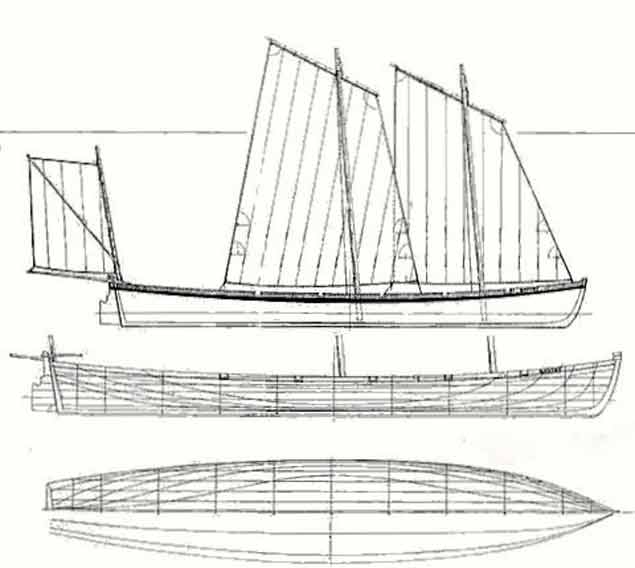 The special vintage rig of the Bantry Boat will be seen as a performance challenge by any genuine sailing enthusiast.
The special vintage rig of the Bantry Boat will be seen as a performance challenge by any genuine sailing enthusiast.
In time the actual Bantry boat herself was taken into the care of ship conservation department at Liverpool University with which John Kearon (originally of Arklow, and later to conserve the Asgard) is so closely involved, and now the gig is on permanent display in the Collins Barracks section of the National Museum in Dublin. But meanwhile the fact that the true plans were in existence had played a role in the next stage of the story.
It began in 1986 when New York Harbor saw the staging of the first Atlantic Challenge events. The brainchild of American marine philanthropist Lance Lee in consultation with Bernard Cadoret, it was based on multi-activity competition between young crews representing the US and France, using replicas of the Bantry longboat.
Recently in Afloat.ie, we’ve carried a report about how the various rowing disciplines and their specialised boat types have been trying to find enough common ground to create an umbrella body to represent the interests of a sport which is undoubtedly growing in all areas and categories, but has difficulty in speaking with a single voice. Yet whether or not the Bantry boats could ever be included in this new grouping is a moot point, for not only are they an intensive rowing experience, but sailing them is an advanced skill in itself.
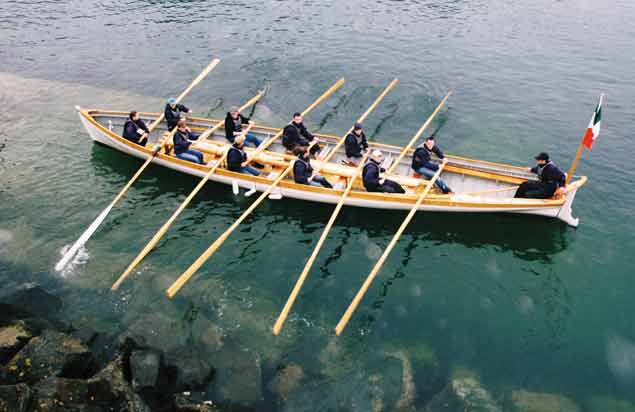 Waterford has been involved in the Atlantic Challenge concept since 2005. This photo of their boat An-Seabhac when new gives and idea of the complexity of the seamanship skills required – the ten 10ft oars have to be stowed in careful order, and the boat is rowed with the complete three-masted rig – including the sails -stowed on board.
Waterford has been involved in the Atlantic Challenge concept since 2005. This photo of their boat An-Seabhac when new gives and idea of the complexity of the seamanship skills required – the ten 10ft oars have to be stowed in careful order, and the boat is rowed with the complete three-masted rig – including the sails -stowed on board.
This was soon learned as the Atlantic Challenge developed from its modest beginnings in 1986. 1988’s was due to be staged in France, and Hal Sisk was invited to see if he could organise an Irish crew. In an inspired decision, he approached people in Bantry such as Dr Matt Murphy and Mark Wickham, and between the rowing club and the sailing club, they got a crew together and headed off to Douarnenez to compete in a borrowed boat, for building Bantry boats as a training and community exercise was becoming something of a movement in itself, and an international movement at that, as the listing of the biennial stagings of the Atlantic Challenge since its foundation reveals:
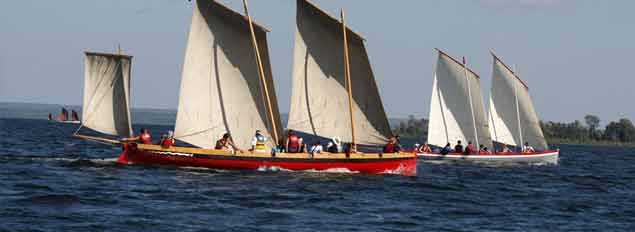 A joy to race under sail. Atlantic Challenge 2010 under way in Ontario, Canada
A joy to race under sail. Atlantic Challenge 2010 under way in Ontario, Canada
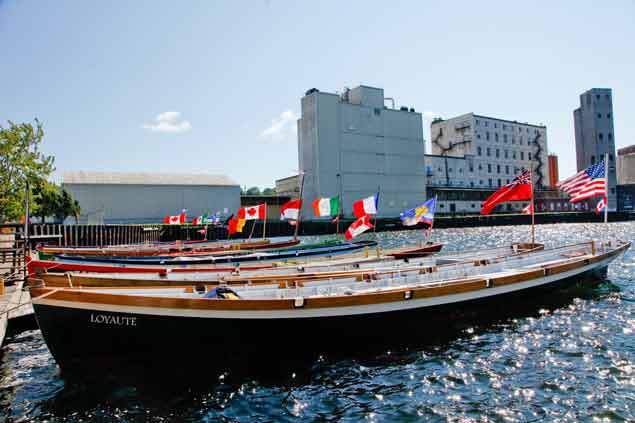 A truly international gathering – Bantry Boats in port in Canada
A truly international gathering – Bantry Boats in port in Canada
ATLANTIC CHALLENGE VENUES:
1986 New York, New York (USA
1988 Douarnenez (France)
1990 Roskilde (Denmark)
1992 Brest (France)
1994 Penetanguishene, Ontario (Canada)
1996 Bantry, County Cork (Ireland)
1998 Roskilde (Denmark)
2000 Douarnenez (France)
2002 Rockland, Maine (USA Maine)
2004 Fishguard, Wales (GB)
2006 Genoa (Italy)
2008 Jakobstad (Finland)
2010 Midland, Ontario (Canada)
2012 Bantry, County Cork (Ireland)
2014 Gulf of Morbihan (France)
2016 Roskilde (Denmark)
And now, for 2018, the Atlantic Challenge will be in Northern Ireland, on our largest lake of Lough Neagh, at Antrim Boat Club in the lake’s northeast corner from July 20th to 28th. The Lough Neagh men have form in this, as they won 2012’s international event at Bantry. But Organising Committee chairman Charlie Macallister and his team – and their clubmates in Antrim BC – are well aware of the high standards of organisation and hospitality they’ll be expected to provide. But equally there’s always the challenge of maintaining a Bantry Boat in good order, and finding, keeping, training and motivating a young crew to a level of performance and success which makes it all worthwhile.
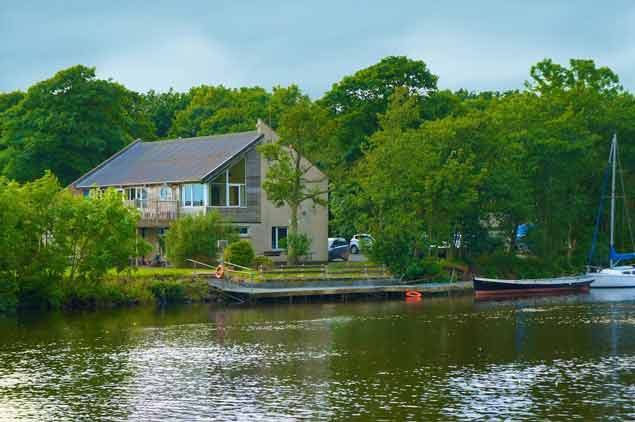 Antrim Boat Club on Lough Neagh with the local Atlantic Challenge’s first boat, the Harmonie, at the club pontoon. Antrim hosts the 2018 Atlantic Challenge from July 20th to 28th.
Antrim Boat Club on Lough Neagh with the local Atlantic Challenge’s first boat, the Harmonie, at the club pontoon. Antrim hosts the 2018 Atlantic Challenge from July 20th to 28th.
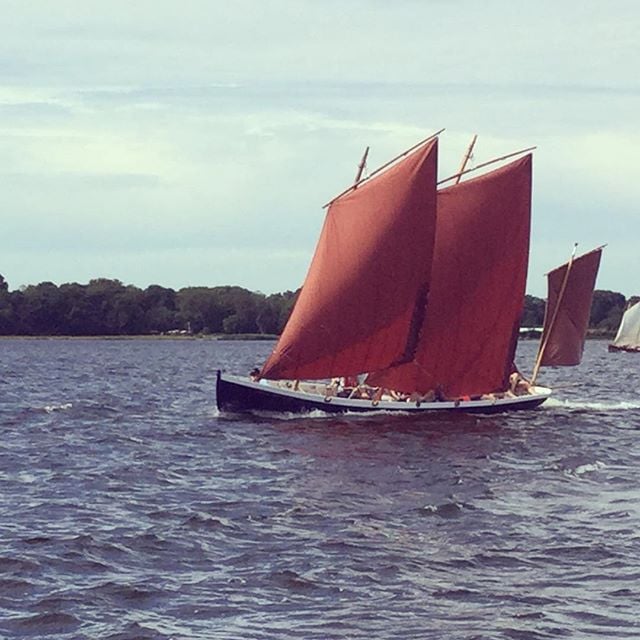 Lough Neagh Bantry Boat Harmonie making knots on her home waters
Lough Neagh Bantry Boat Harmonie making knots on her home waters
For although the ideal is to build one of the boats as a community effort, the reality is that two or three skilled boatwrights can soon build one on their own. But in order to use the boat to her full potential, you need the numbers of a football team, plus two or three extra, to provide the full crew. In an age where other forms of rowing, other forms of sailing and indeed other forms of sport and recreation are readily available as rival distractions for potential crew, that’s a formidable challenge.
Yet over the years, people have found that the attractions of setting up a local Bantry Boat project are irresistible. They provide so much in one package – a beautiful and historically significant boat which can push towards 10 knots when being rowed by her ten 10ft oars, then when it’s time for the sailing part o the competition, those huge oars have to be skillfully stowed in a strictly choreographed programme in order to allow the ancient yet very effective three-masted rig to be set up.
No-one with a taste for sailing which is decidedly different to your modern high-tech stuff could resist the challenge of getting optimum performance from a Bantry Boat’s rig. Subtle differences in the relative trim of the three sails can hugely affect performance, but it’s a joy when they get it just right – Charlie Macallister was telling me that at an event in Wales, he was aboard a support boat which timed one of the Bantry Boats smoking along at a good 16–knots under sail.
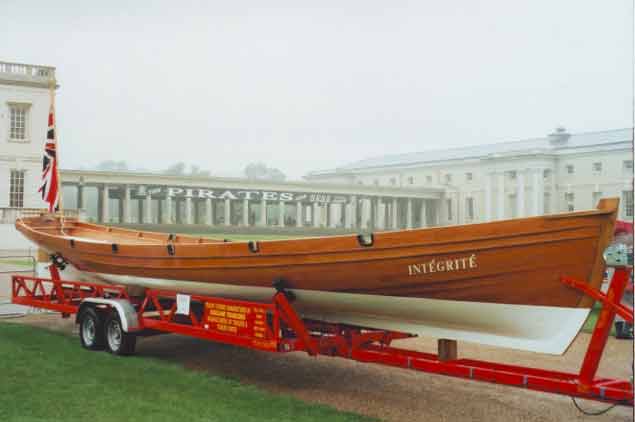 A pleasure to behold – the Atlantic Challenge Longboat Integrite makes her debut appearance at Greenwich Maritime Museum in London
A pleasure to behold – the Atlantic Challenge Longboat Integrite makes her debut appearance at Greenwich Maritime Museum in London
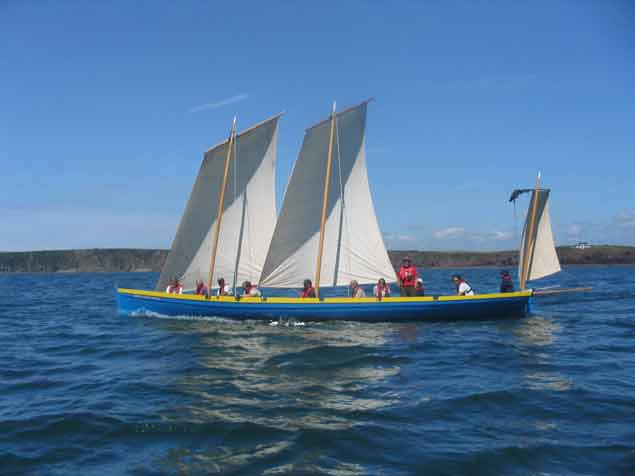 A fresh expression of a coastal town’s maritime spirit. This is the Lyme Regis boat sailing in the English Channel off the coast of Dorset
A fresh expression of a coastal town’s maritime spirit. This is the Lyme Regis boat sailing in the English Channel off the coast of Dorset
So the appeal is there, and when it works for a local community – as it does so well, for instance, at Lyme Regis in the heart of England’s south coast – then it can be a very fulfilling and beneficial project. It works, too, when there’s a certain level of official support in more structured societies. In the early 1990s, Lance Lee gave encouragement to the setting up of an Atlantic Challenge boat-building shop in Russia. That produced boats and a programme which received a level of official approval, and in time the Russians sent a build-team to Finland to help them set up something similar there.
This all acquired an extra international dimension when the Russians won the most recent Atlantic Challenge contest at the historic port of Roskilde in Denmark in 2016, which means that come July, the complex competition of rowing, seamanship skills and sailing skill on Lough Neagh will see the Russians as defending champions.
So the original idea of 1986 continues to have growing international appeal 32 years down the line, yet in Ireland while we have some high-profile Bantry Boats, numbers have always been modest, and although it’s reckoned that in all perhaps as many as 80 Bantry Boats have been built worldwide, the sad reality is that some of them have had a decidedly short active lifespan, as the initial enthusiasm and shared effort of building the boat fails to be followed by the continuous and sometimes exhausting dedication which is needed to keep such a programme alive.
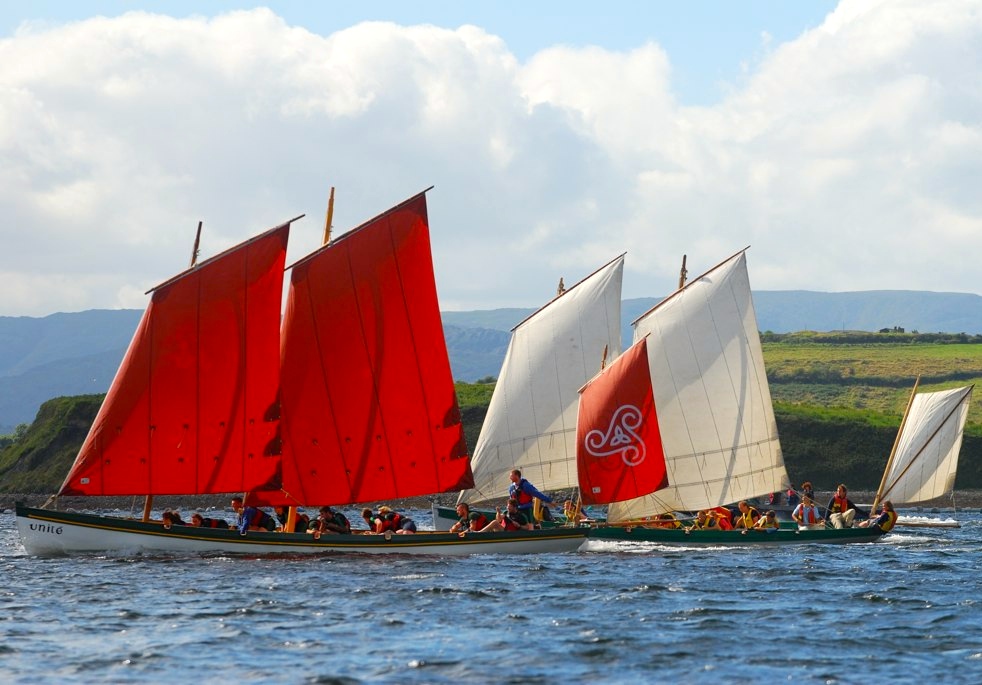 Home waters. Bantry Boats racing in the Atlantic Challenge at Bantry in 2012, when the winner was the Antrim crew with Bantry second
Home waters. Bantry Boats racing in the Atlantic Challenge at Bantry in 2012, when the winner was the Antrim crew with Bantry second
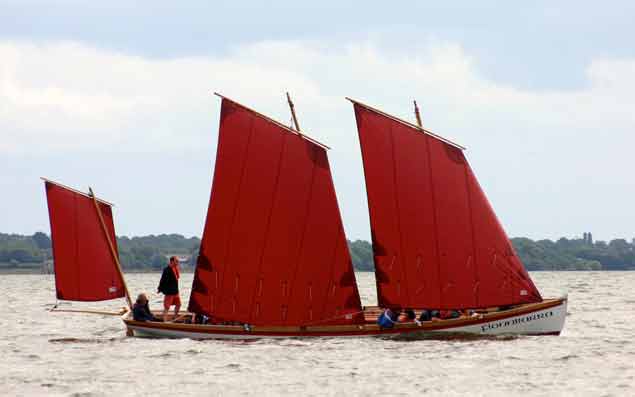 Cork’s Bantry Boat Fionnbarra, community-built by Meitheal Mara, and with rig perfectly set up.
Cork’s Bantry Boat Fionnbarra, community-built by Meitheal Mara, and with rig perfectly set up.
Yet it can be done, but it needs somewhere very special, and one of those special communities – most appropriately - is Bantry itself. There, the town’s maritime awareness has been further buoyed up by the new in-harbour marina, the place is buzzing generally as one of the main towns of increasingly prosperous West Cork, and in Diarmuid Murphy – son of Dr Matt Murphy who was one of the first Bantry people Hal Sisk went to when researching the possibilities of a Bantry crew back in 1987 – we have a total maritime enthusiast. He’s the main man at Bantry’s Fish Kitchen restaurant and the Fish Market shop, and is suitably fired up and ideally placed to keep the local 1990-built Bantry Boat Unite in proper commission and fully crewed.
His enthusiasm is infectious. He reckons the winning combination lies in Bantry’s continually-growing maritime enthusiasm and the fact that they have expanding rowing and sailing clubs side-by-side: “There’s great cross-fertilisation between the two, and guys or girls who come to us from the rowing club could end up becoming sailors, and vice versa. The too, there’s a great tradition of active team sports in West Cork in particular. Sailing or rowing a Bantry Boat is very much a team sport, and a good positive attitude helps it all along”.
Another factor is having a developing community which is growing, but not at an unhealthily fast rate. A notable contrast to Bantry in Ireland is Banagher on the Shannon, where a fine Bantry Boat was built in 2012, but with a shrinking population, the word is that these days they just can’t get the crew.
At the other end of the urban scale, the city of Genoa in Italy hosted the Atlantic Challenge in 2006 and the City Fathers had great hopes of having a local fleet. But here again we’re told they just can’t get a crew together - not because Genoa lacks population, but because there isn’t that localized sense of maritime community, with individuals prepared to give voluntarily of their time.
As for Dublin, thriving traditional coastal rowing clubs such as St Michael’s in Dun Laoghaire and Stella Maris in Ringsend already provide the energetic focal points which gather up all potential local enthusiasm, and there simply wasn’t the energy and resources space to keep a Bantry Boat on the go after one had been built in 1996. For everyone may have set out with the best of hopes, as these are seductively attractive boats, yet of the eighty built since 1986, many have faded away.
But when they prosper, it’s a wonder to behold, and everybody wants a part of them. When the Ilen Boat-building School in Limerick made a deal to provide a new paint job and some repairs to Bantry’s Unite in the winter of 2008-2009, part of the deal was that when the job was done the boat could be used to row the Mayor of Limerick John Gilligan out to Scattery Island in the Shannon Estuary for the ancient dart-throwing ceremony to remind everyone that the Mayor of Limerick is Lord Admiral of the Shannon Estuary.
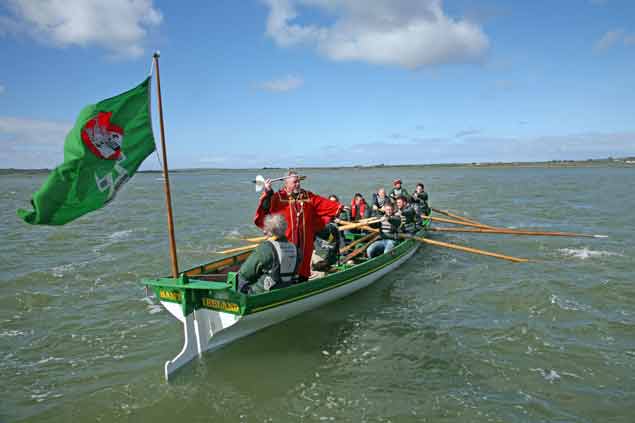 Re-fitted by Limerick’s Ilen Boat-building School, Bantry’s own Bantry Boat from West Cork provides the launch vessel when the Mayor of Limerick John Gilligan asserts his rights as Admiral of the Shannon Estuary with the ancient dart-throwing ceremony at Scattery Island. Photo: Gary MacMahon
Re-fitted by Limerick’s Ilen Boat-building School, Bantry’s own Bantry Boat from West Cork provides the launch vessel when the Mayor of Limerick John Gilligan asserts his rights as Admiral of the Shannon Estuary with the ancient dart-throwing ceremony at Scattery Island. Photo: Gary MacMahon
Such things are just grand when the boat has enjoyed a comfortable winter in the cosseted comfort of the Ilen School’s workshop. But maintaining a classically-built open 38-footer year-on-year in Ireland’s damp and windy climate is quite a challenge, and it was in pursuing this gloomy line of thought that my day was made by Diarmuid Murphy’s final cheery answer.
“Where do we store her for the winter? We store her in the unused hangar at Bantry Aerodrome” says he. There you have it, the Third Sacred Secret in the success of Bantry’s own longboat. And no, I didn’t know either that Bantry had its own little airstrip – but they do. And as there’s space in the hangar for Cork’s own Bantry Boat too, they give her winter sanctuary as well.
It rounds out the story. Bantry, by having the prefect preservation pod in the Bantry House Boathouse, kept the longboat alive and well until she was 154 years old. After that, she was taken over by others, and now at 228 years old, is safely conserved in the National Museum.
And as for some of the active descendants in Ireland, it’s the fortuitous presence of a disused hangar at Bantry Aerodrome which is central to their comfortable survival. When it all comes together on Lough Neagh on 20th July, this extraordinary story will open a new chapter. And it’s anyone’s guess where that will lead.
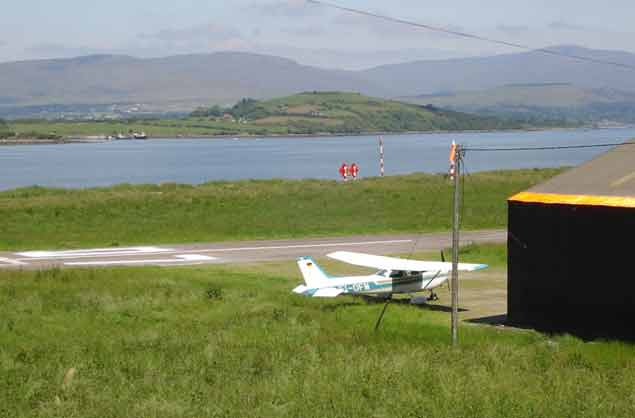 Bantry’s best-kept secret – the airstrip. The under-used hangar on the right is ideal for sheltering two Bantry Boats through the winter.
Bantry’s best-kept secret – the airstrip. The under-used hangar on the right is ideal for sheltering two Bantry Boats through the winter.



























